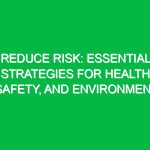Hello Team!
Today, we’re gathering for a crucial toolbox talk focused on a common but often overlooked hazard in our work Environment: Muddy Work Areas. It’s essential to understand how these areas can impact our Safety and productivity. By the end of this session, I want you to feel equipped with knowledge and strategies to navigate these muddy conditions safely and effectively.
Understanding Muddy Work Areas
Muddy work areas refer to sections of a job site where water accumulation or wet conditions create soft, unstable ground. This situation is common in various industries, especially construction, landscaping, and agriculture. The presence of mud can make surfaces slippery and increase the risk of slips, trips, and falls, which are among the leading causes of workplace injuries.
The Importance of Addressing Muddy Work Areas
Why should we care about muddy work areas? Well, the answer is simple: safety. Muddy conditions not only pose physical risks but can also affect our equipment and overall work efficiency. Here are some key reasons:
- Injury Prevention: By understanding and addressing muddy areas, we reduce the risk of accidents that can lead to serious injuries.
- Equipment Safety: Mud can cause machinery to become stuck or damaged, leading to costly repairs and downtime.
- Work Efficiency: Navigating muddy areas can slow down our progress. By implementing effective strategies, we can ensure a smoother workflow.
Identifying Hazards in Muddy Work Areas
To effectively manage muddy work areas, we first need to identify the potential Hazards they present:
- Slips, Trips, and Falls: The most obvious risk. Wet and muddy surfaces can easily lead to loss of balance.
- Equipment Instability: Uneven and soft ground can cause machinery to tip or sink, creating dangerous situations.
- Injury from Falling Objects: If workers are moving through muddy areas, they may inadvertently disturb tools or materials, leading to falling hazards.
- Decreased Visibility: Mud can obscure markings on the ground, making it harder to see hazards or changes in terrain.
Real-Life Examples
Let’s consider a hypothetical scenario: Imagine a construction site after a heavy rain. The ground is saturated, creating large puddles and muddy patches. A worker is tasked with transporting materials across the site. Without proper Precautions, they may slip, fall, or even drop materials, which could injure themselves or others.
Now think about a real-life incident where a team member slipped in a muddy area and sprained their ankle. This not only caused pain and discomfort for the individual but also led to lost workdays and impacted the project timeline. Such incidents highlight the critical need for awareness and preventive measures.
Best Practices for Working in Muddy Conditions
Now that we’ve discussed the risks, let’s talk about some effective strategies to stay safe in muddy work areas:
- Wear Appropriate Footwear: Make sure to wear boots with good traction designed for wet conditions. This can significantly reduce the risk of slipping.
- Establish a Safe Path: Whenever possible, identify and mark safe paths to navigate through muddy areas. Use boards or mats to create stable walkways.
- Keep Work Areas Clear: Regularly clean up tools, materials, and debris from muddy areas to minimize trip hazards.
- Use Equipment Wisely: When using machinery, ensure it is suitable for muddy conditions. Consider using tracks or specialized tires that enhance stability.
- Communicate: Always inform your team about muddy conditions and potential hazards. Clear communication can prevent accidents.
Regulations and Standards
It’s essential to understand that there are Regulations and standards governing Workplace Safety, including those related to muddy work areas. The Occupational Safety and Health Administration (OSHA) outlines guidelines that address slip, trip, and Fall Hazards. Compliance with these regulations not only ensures safety but also protects our company from potential legal issues.
When we follow these guidelines, we contribute to a safer work environment and demonstrate our commitment to health and safety standards.
Engaging with the Team
Now that we’ve covered the key points, I’d like to invite you to share your thoughts and experiences. Have any of you encountered particularly challenging muddy conditions? How did you handle it? What strategies worked for you? Your insights can be invaluable in creating a safer environment for everyone.
Conclusion
As we wrap up this toolbox talk, let’s remember the importance of addressing Muddy Work Areas. By recognizing the hazards, implementing Best Practices, and following regulations, we can significantly reduce risks and maintain a safe working environment. Thank you all for your attention today and for your ongoing commitment to health, safety, and environmental practices. Remember, safety is a collective responsibility, and each of us plays a vital role in ensuring a safe workplace.


